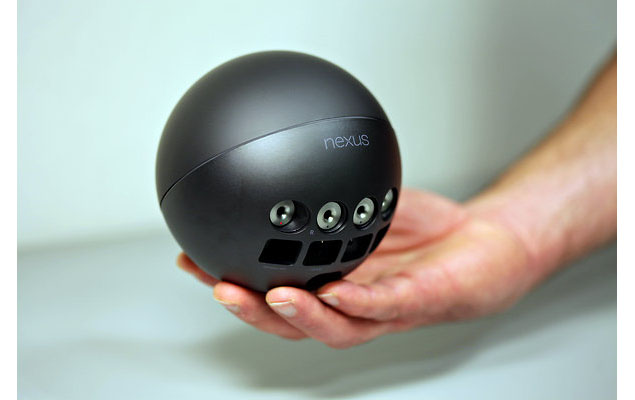Google tries something retro: Made in the U.S.A.

The Google executives and engineers who decided to build the player here are engaged in an experiment in American manufacturing. "We've been absent for so long, we decided, 'Why don't we try it and see what happens?' " said Andy Rubin, the Google executive who leads the company's Android mobile business.
Google is not saying a lot about its domestic manufacturing, declining even to disclose publicly where the factory is in Silicon Valley. It also is not saying much about the source of many of its parts in the United States. And Mr. Rubin said the company was not engaged in a crusade.
Still, the project will be closely watched by other electronics companies. It has become accepted wisdom that consumer electronics products can no longer be made in the United States. During the last decade, abundant low-cost Chinese labor and looser environmental regulations have virtually erased what was once a vibrant American industry.
Since the 1990s, one American company after another, including Hewlett-Packard, Dell and Apple, has become a design and marketing shell, with production shifted to contract manufacturers in Shenzhen and elsewhere in China.
Now that trend may be showing early signs of reversing.
It's a trickle, but some American companies are again making products in the United States. While many of those companies have been small, like ET Water Systems, there have also been some highly visible moves by America's largest consumer and industrial manufacturers. General Electric and Caterpillar, for example, have moved assembly operations back to the United States in the last year. (Airbus, a European company, is said to be near a deal to build jets in Alabama.)
There is no single reason for the change. Rising labor and energy costs have made manufacturing in China significantly more expensive; transportation costs have risen; companies have become increasingly aware of the risks of the theft of intellectual property when products are made in China; and in a business where time-to-market is a competitive advantage, it is easier for engineers to drive 10 minutes on the freeway to the factory than to fly for 16 hours.
That was true for ET Water Systems, a California company. "You need a collaboration that is real time," said Pat McIntyre, chief executive of the maker of irrigation management systems, which recently moved its manufacturing operation from Dalian, China, to Silicon Valley. "We prefer local, frankly, because sending one of our people to China for two weeks at a time is challenging."
Harold L. Sirkin, a managing director at Boston Consulting Group, said, "At 58 cents an hour, bringing manufacturing back was impossible, but at $3 to $6 an hour, where wages are today in coastal China, all of a sudden the equation changes."
The firm reported in April that one-third of American companies with revenue greater than $1 billion were either planning or considering to move manufacturing back to the United States. Boston Consulting predicted that the reversal could bring two million to three million jobs back to this country.
"The companies who are investing in technology in the U.S.A. are more nimble and agile," said Drew Greenblatt, president and owner of Marlin Steel Wire Products in Baltimore, which continues to manufacture in the United States by relying on automation technologies. "Parts are made quicker, and the quality is better."
Other factors are playing a role as well, said Mitch Free, chief executive and founder ofMfg.com, an electronic marketplace for manufacturing firms. He pointed to trends including distributed manufacturing and customization as playing an important role in the "reshoring" of manufacturing to the United States.
The biggest challenge in bringing manufacturing home has been finding component suppliers nearby. Industry executives note that the decision to stay in China is often determined by a ready labor pool and the web of parts suppliers that surround giant assembly operations, like the one that Foxconn, the manufacturing partner of Apple and many other big electronics companies, operates in Shenzhen.
The Nexus Q, which links a TV or home sound system to the Internet cloud to play video and audio content, contains almost all American-made parts. The engineers who led the effort to build the device, which is based on the same microprocessor used in Android smartphones and contains seven printed circuit boards, found the maker of the zinc metal base in the Midwest and a supplier for the molded plastic components in Southern California.
Copyright 2012, The New York Times
Catch the latest from the Consumer Electronics Show on Gadgets 360, at our CES 2026 hub.
Related Stories
- Samsung Galaxy Unpacked 2025
- ChatGPT
- Redmi Note 14 Pro+
- iPhone 16
- Apple Vision Pro
- Oneplus 12
- OnePlus Nord CE 3 Lite 5G
- iPhone 13
- Xiaomi 14 Pro
- Oppo Find N3
- Tecno Spark Go (2023)
- Realme V30
- Best Phones Under 25000
- Samsung Galaxy S24 Series
- Cryptocurrency
- iQoo 12
- Samsung Galaxy S24 Ultra
- Giottus
- Samsung Galaxy Z Flip 5
- Apple 'Scary Fast'
- Housefull 5
- GoPro Hero 12 Black Review
- Invincible Season 2
- JioGlass
- HD Ready TV
- Laptop Under 50000
- Smartwatch Under 10000
- Latest Mobile Phones
- Compare Phones
- Tecno Spark Go 3
- iQOO Z11 Turbo
- OPPO A6c
- Samsung Galaxy A07 5G
- Vivo Y500i
- OnePlus Turbo 6V
- OnePlus Turbo 6
- Itel Zeno 20 Max
- Lenovo Yoga Slim 7x (2025)
- Lenovo Yoga Slim 7a
- Lenovo Idea Tab Plus
- Realme Pad 3
- Garmin Quatix 8 Pro
- NoiseFit Pro 6R
- Haier H5E Series
- Acerpure Nitro Z Series 100-inch QLED TV
- Asus ROG Ally
- Nintendo Switch Lite
- Haier 1.6 Ton 5 Star Inverter Split AC (HSU19G-MZAID5BN-INV)
- Haier 1.6 Ton 5 Star Inverter Split AC (HSU19G-MZAIM5BN-INV)
















